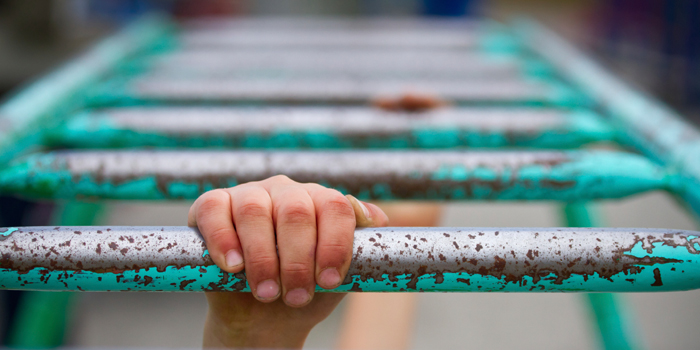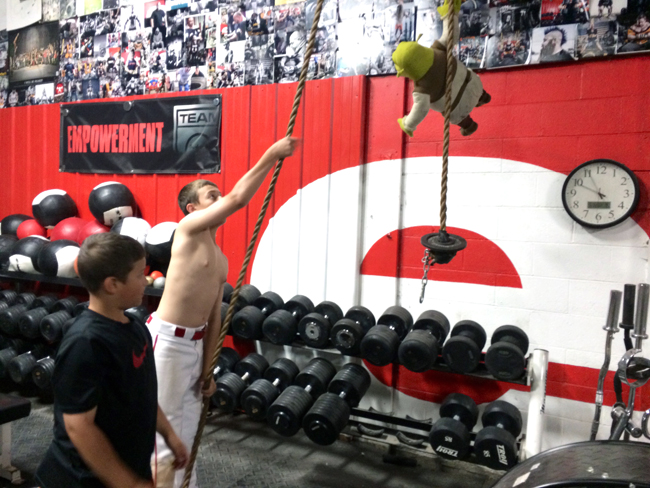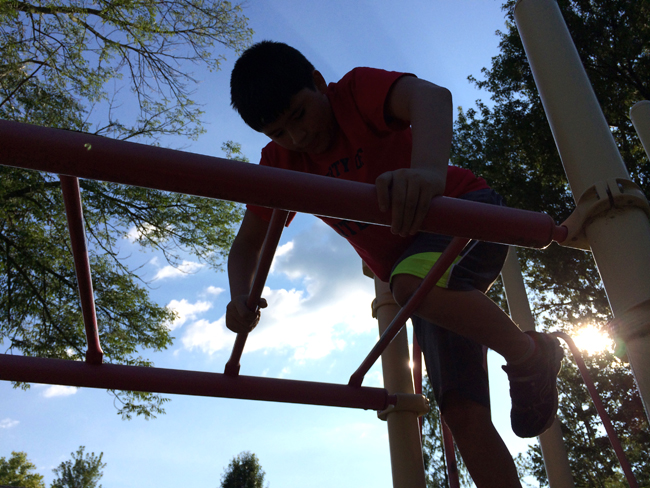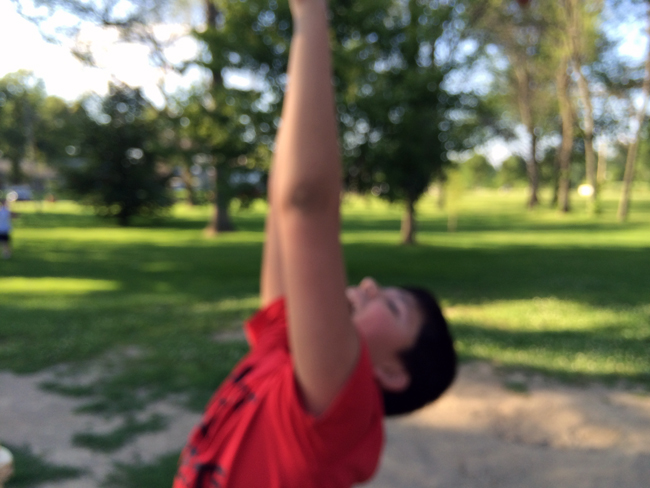
“I am going to fail with this next squat attempt. My chest will cave, my knees will buckle.”
Seconds before attempting the last set of squats, these thoughts flooded my lifting partner’s brain. She whispered these exact words into my ear as I was tugging on the tapered tongue of her belt, helping her to secure the prong at it’s tightest fit.
Despite my words of encouragement and plea for her to ban self-doubt, she needed the assistance of the side spotters to lift the bar back into the rack.
When is the last time you let your thoughts undermine your ability to accomplish a task? At any age, fear can creep up on us and put our best-intentioned efforts to a screeching halt.
Similarly, just the other day a client of mine refused to use his left hand (his weaker of the two) to complete single-arm rows. His exact words were, “My left hand is weaker. I know I won’t get the same amount of reps. What’s the point?”
Twenty years of age between the two, both had let fear take over.
I’ve seen fear and fearlessness dominate cognitive and physical ability on the playground, in the classroom, the gym, and in home. In these distinct settings—a child’s world—informal and formal lessons shape the degree into which he or she perceives the world, interacts, and develops. If fearful, perception, interaction, and development suffer immensely.
It was outside the walls of my master’s in education and my experience working in the public school that my sense of fear really took shape. It wasn’t until I began working as a behavior specialist in a partial hospitalization program that I first saw the true effects of fear.
This program consisted of children that could no longer be optimally cared for in the public school. Stemming from erratic behavior unsuitable in a class size of thirty children and one teacher, most of these children were riddled with one or multiple diagnoses (schizophrenia, depression, ADHD, ADD, autism, bipolar disorder etc.), were prescribed an onslaught amount of medication, and were growing up in a home with unsuitable parental care. Tracking and collecting behavioral data within this academic setting indicated that fear was a primary emotion.
After my experience in the partial-hospitalization program, I led a 26-member team of clinicians, behavior specialists, teachers, and classroom aides where we created a daily 4-month summer camp and therapeutic experience to meet the individual, social, and recreational/fitness needs of children with Aspergers. Compared to the previous position, this therapeutic experience shifted emphasis from fixing the child to creating an environment where the needs of the children determined the curriculum. Fear was not the primary emotion within this setting.
While working with Suzanne Gray at Right Fit in Chicago, I became the fitness director of special needs and programmed for children and adults with autism. This shift in setting, population (working with children on the entire spectrum), curriculum, and means of assessment continued to reconfigure my approach to teaching. Again, the emphasis was creating an environment where the needs of the children determined the curriculum. The ability to work one-on-one with children and parents with the purpose of maximizing ability through movement minimized fear and child ability flourished.
One prominent fear I’ve seen plague the playground is fear of the monkey bars. Think about it…this playground staple is setup for a child to use his or her grip and back strength to move across approximately 12 feet of steel bars, one hand at a time.
Now imagine the child with special needs. He has experienced failure over and over again, is frightened of heights, and has a weak grip. Is it bizarre to think this same child would want nothing to do with the monkey bars, let alone any other physical task that requires effort?
Below is a 12-week exercise progression for the child with special needs whom specifically fears the monkey bars. The progression is a template to illustrate how to maximize ability and overcome fear through appropriate exercise and presentation. Teaching points you’ll find helpful throughout are:
- Every week attention is given to the neural/motor patterns responsible for completing the desired task.
- Similar exercises and activities mimic/replicate the desired task.
- During the session, expectations are modeled by trainer.
- Physical and verbal assistance/cues are heavy from the start and lessen/alter as body awareness, skill proficiency, and confidence increases.
- The environment changes when appropriate.
- Play is the leading component.
Note: Each week’s progression may be extended as long as needed. For example, Week 2 may take a revisit for three weeks before moving on to Week 3. Also, these exercises/steps are intended to play a part in a 30- to 60-minute training session.
12-Week Monkey Bar Exercise Progression
Week 1: Sand Bin Money Find
How-To: Fill a large plastic bin 3/4 full with sand. Mix 10 quarters within the sand. The goal, using both hands, is to find the 10 quarters. Emphasize using both hands to dig through the sand. As they are found, place quarters in a pile next to bin.
Benefit: This fine motor work will engage the use of both arms, their rotation, and have the child continuously open and close their hands and fingers.
Verbal/Physical Cues: Use both hands, dig, right hand has to find this one, left hand has to find this one, find the quarter.
Set x Rep: 1 x 10 quarters are collected
Week 2: Shrek Seated Sled Pulls
How-To: Add two single-arm spud straps to a sled using carabineers. Add weight to sled (something they’ll be able to row for sets of 12-15. Add a stuffed Shrek, or stuffed animal they like, to the stack of weight, securing the arm/head/leg/body of the stuffed animal with Velcro. Facing the sled, each hand securing a spud strap, model how to extend arms, row arms simultaneously until sides of hands make contact with lower abdomen (moving the sled towards you), and stepping back to complete another row.
Benefit: Again focus on using each hand/arm independently. Grip comes to play, as does the use of the back and core.
Verbal/Physical Cues: Stand tall, belly full, squeeze straps, pull steady, stretch lats, pull Shrek toward you.
Set x Rep: 2 x 12-15 reps
Week 3: Seated Pull-down Machine
How-To: Using a MAG Medium Grip Pronate attachment, grip the bar. Sit on seat and secure knees underneath pad. Pull the bar down to top of head. Reverse bar path, shy of the starting position, for a big lat stretch.
Benefit: This exercise puts the child in a similar monkey bar position, yet with the comfort of sitting in a fixed position. The attachment has unique palm support and reinforces force dispersion throughout the entire hand.
Verbal/Physical Cues:
Set x Rep: 3 x 10
Week 4: Assisted Pull-up Machine
How-To: With one knee on the pad and the other foot on the stand, use a medium grip (arms shoulder width) to grip the pull-up bar. Once a firm grip is secured, place both knees on pad. Pull-up until chin makes contact with bar. Adjust the weight so that he or she can get at least 10-12 reps.
Benefit: Comparable to the last exercise, the lower body is primarily in a fixed position, yet is moving in sync with each pull up. Grip mimics the monkey bar position with use of back and core.
Verbal/Physical Cues: Squeeze the bar, belly full, lightly touch chin to bar, pull, hang, stretch lats.
Set x Rep: 2 x 10-12 reps
Week 5: Shrek Rope Pull-down
How-To: In this video, you’ll see a rope pulley setup with Shrek attached. This is an upright pull down. With one arm at a time, pull the rope down until it makes contact with chest. As the rope continues to pull down, Shrek (and added weight) is raised to the ceiling. Once Shrek reaches the ceiling, reverse the pull down until Shrek is on the floor.
If this setup is not attainable, add a rope to the sled (using a carabineer attachment or knot) and pull the rope (one arm at a time) until the sled reaches your feet.
Benefit: The pulley system changes the angle of the row previously done. Rather than one arm/lat potentially compensating when pulling together, each side of the body is partially isolated. Grip comes to play, as does the use of the back and core.
Verbal/Physical Cues: Pull with your lats, elbows down, pull, squeeze rope, belly full, smooth pulls, one arm at a time.
Set x Rep: 3 x Shrek to ceiling and back to ground -Or-
3 x Sled pulls to feet
Week 6: Angry Bird Static Hangs
How-To: Using a modified pull-up bar (the height of the bar can be reached as the child stands up on their tip toes and extends their arms) the child will grip the bar and hang (feet grazing the ground). Standing three feet away, you or another player will have a bin full of plush stuffed animals. Aim Angry Birds (or another small plush stuffed animal) at the child’s stomach (mark an X using chalk on their shirt and stress “do not hit the face”). The goal is to make contact with the child by aiming for the X. Each Angry Bird that makes contact earns the thrower a point.
Benefit: The bar is low enough that as the child hangs and loses grip, he or she is a hair off the ground. This allows the child to get the feel of losing grip from the bar and landing on his or her feet. Grip comes to play in a very direct way since the child is statically holding, waiting as the other player gets through all his stuffed animals.
No longer is the focus hanging and losing your grip, but instead, it’s on your friend hitting the X. This is really a fun game.
Verbal/Physical Cues: Tight grip, aim for the X, belly full, land on both feet.
Set x Rep: 2 x 10 stuffed animals (players taking turns each round and regaining grip if grip is lost)
Week 7: Playground Climbs to Slide
How-To: Moving from the gym to the playground, today’s focus is to climb on the playground and slide. At most playgrounds, there are multiple ways to climb the structure to get to one slide (at multiple heights). Find 5 different ways to climb up to the slide (chained steps, ladder stairs, parallel bars, climb up the slide, etc.)
Benefit: The focus at the playground is climbing and sliding. The constant climbing and variety in equipment continues to build those muscles responsible for monkey bar swings. Also, it’ll be beneficial for the child to associate the playground with something other than the monkey bars.
Verbal/Physical Cues: Climb, use your arms, squeeze the bar, leg drive, slide down.
Set x Rep: 5 x 1
Week 8: Piggy Back Ride Stop and Go
How-To: Mark a stretched distance with cones or chalked lines. Have the child step up onto a sturdy chair, a tire, or bench. Position yourself in front of the child, facing away. Close to the child, cue him or her to place both of their hands around your shoulders. One leg at a time, cue him or her to wrap their legs around your waist.
This game is similar to Red Light Green Light. Starting at one end, have the child say “stop” and “go.” When the child says “stop”, stop. When the child says “go”, walk forward to reach the destination. For variety, you can add players and race against them. Instead of verbal cues, a player can be at the “finish” line with red and green colored ribbons or paper. Red signals stop and green signals go.
Benefit: Piggyback rides are often a go-to for children because they place the child in a comfortable position in full contact with another. Although offthe ground, the fear of heights is lessened or completely out of mind.In future weeks, piggyback support will take place when approaching the monkey bars. Therefore, the Stop and Go game will provide a positive experience to transition forward.
Verbal/Physical Cues: Hold on to me, squeeze arms, squeeze legs, Stop, Go, Red, Green
Set x Rep: 2 x 1 (cone to cone)
Week 9: Stuffed Animal Monkey Bar 3-Second Grab Carry
How-To: Allow the child to choose a stuffed animal (or something related) to bring to the playground. Explain that today the stuffed animal will be completing the monkey bars with help. Holding the stuffed animal in hand, model how the stuffed animal swings from one bar to the other with assistance. Once both hands are on one bar, hold for 3 seconds, then repeat. Give attention to how you’re close and helping and verbalize the stuffed animal’s body position: tight, using lats, keeping grip strong, holding for 3 seconds, etc.
Benefit: This exercise provides a visual for the child. He or she can hear and see your role in allowing the entire process to be attainable and safe.This exercise will also model expectations for the future.
Verbal/Physical Cues: Look at his/her form, I’m close, I’m helping, lats are tight, belly full, one arm at a time, 3-second hold, 1-2-3.
Set x Rep: 1 x length of monkey bars
Week 10: Monkey Bar Grab Carry
How-To: Assume piggyback position. Underneath the monkey bars, the child will reach for each bar, one hand at a time. The goal is for the child to have one hand around the shoulder and the other to secure the bar in hand. Continue this until all bars have been secured.
Benefit: Up to this point, the child has had good experiences in the piggyback position and is familiar with watching the stuffed animal do this the week prior. This exercise allows the child to complete something familiar and he or she will get used to how the bar feels in his or her hands.
Verbal/Physical Cues: I’m close, I’m helping, lats are tight, belly full, one arm at a time, squeeze the bar.
Set x Rep: 1 x length of monkey bars
Week 11: Monkey Bar Setup with Static Hold
How-To: Model to the child how to climb up the playground structure to get to the monkey bars. Model how to stand on the edge of the platform and reach for the bar. Grasp the barwith both hands.Have the child try. As the child tries, stand before him or her on the ground. Explain how you’ll secure their legs once their holding tightly onto the bar. Hold position for three seconds and bring the child down to the ground to standing position.
Benefit: This setup provides expectations of how to approach the monkey bars. Also, the support system is slightly lessened because they are no longer in piggyback position (chest and back are no longer assisted).
Verbal/Physical Cues: Stand tall, belly full, squeeze bar, hold for three seconds, 1-2-3, I’m here, I have your legs.
Set x Rep: 5 x 1
Week 12: Monkey Bar Swing and Drop
How-To: Model to the child how to climb up the playground structure to get to the monkey bars. Model how to stand on the edge of the platform and reach for the bar. Grasp the barwith both hands.Have the child try. As the child tries, stand before him or her on the ground. Explain how you’ll secure their legs once their holding tightly onto the bar. Securing their legs, the child will hold the hang position for three seconds and then swing one arm forward to reach and grab the next bar. Secure the bar in hand. Do the same with the other hand. With both hands securing the same bar, hold position for three seconds. Explain how you will let go of their feet after the 3-second hold and they are to then land on the ground with both feet.
Benefit: The setup and your role will be familiar. He or she will also be used to reaching for the bar with one hand while having support. The 3-second hold gives the child a pace to work with.
Similar to the Angry Bird game, in this exercise they’ll resume the static hold position. As this drop will be slightly farther than the modified bar, they’ll be familiar with the cue of landing on both feet.
Because falling and getting hurt is one major area of uncertainty for the child, we’ll be practicing this aspect over and over. The message that’ll be conveyed is that “you’ll eventually lose grip. Here’s how to land on the ground and then try again.”
Verbal/Physical Cues: Stand tall, tight grip, belly full, land on both feet, one arm at a time, 3-second hold, 1-2-3, hold for three seconds, I’m here, I have your legs, hang, let go of bar, land on both feet.
Set x Rep: 3 x 1 swing and drop
To further this progression, go from one complete swing to a drop, to two complete swings to a drop. Continue this progression until all bars are reached.
Moving forward, consider how you can continue to lessen the amount of cues and support. Fear can either be a limiting factor or, by overcoming it, a method of building a lifetime’s worth of confidence. Continue to incorporate prior lessons into training and constantly change load, tempo, attachments, and game rules.
Since working with Suzanne, I’d like to thank the following individuals that continue to allow my systems of training evolve: Suzanne Gray, Dr. Anat Baniel, Dr. Nefi Charalambous-Darden, Matt Wenning, Amy Wattles, Traci Tate, Dave Tate, and Blaine Tate.













Complaints from her school that she can’t do Monkey
Bars. Can u help regarding this